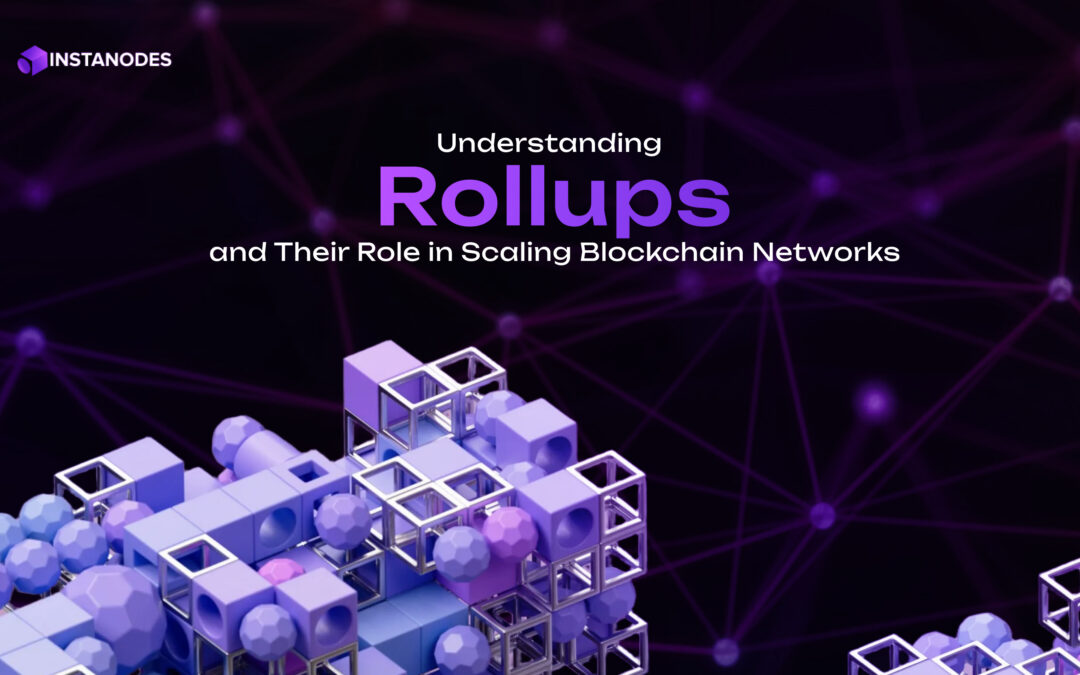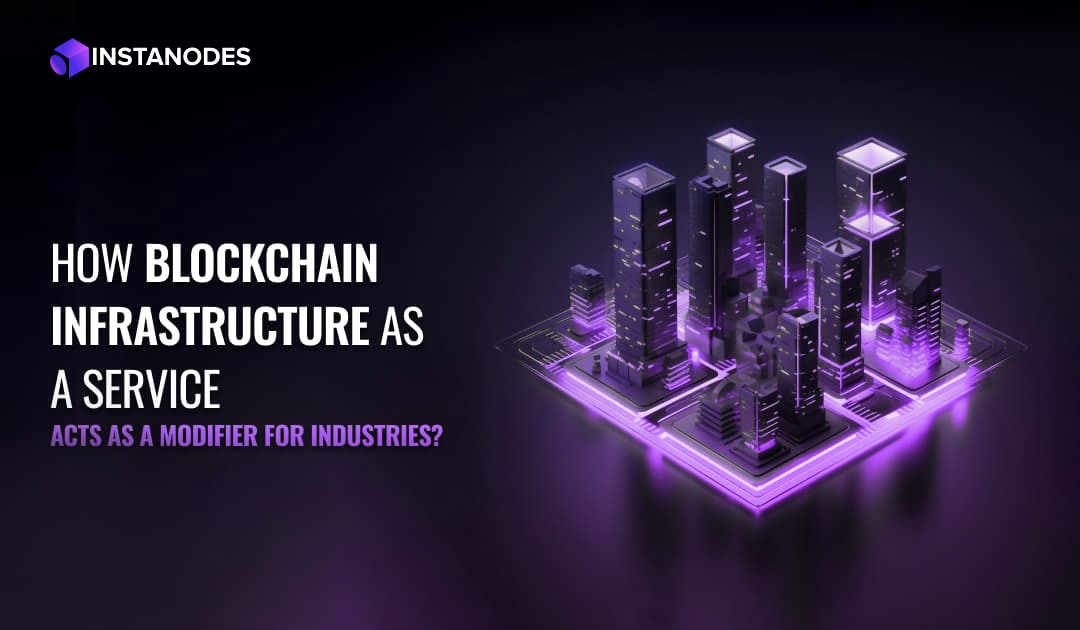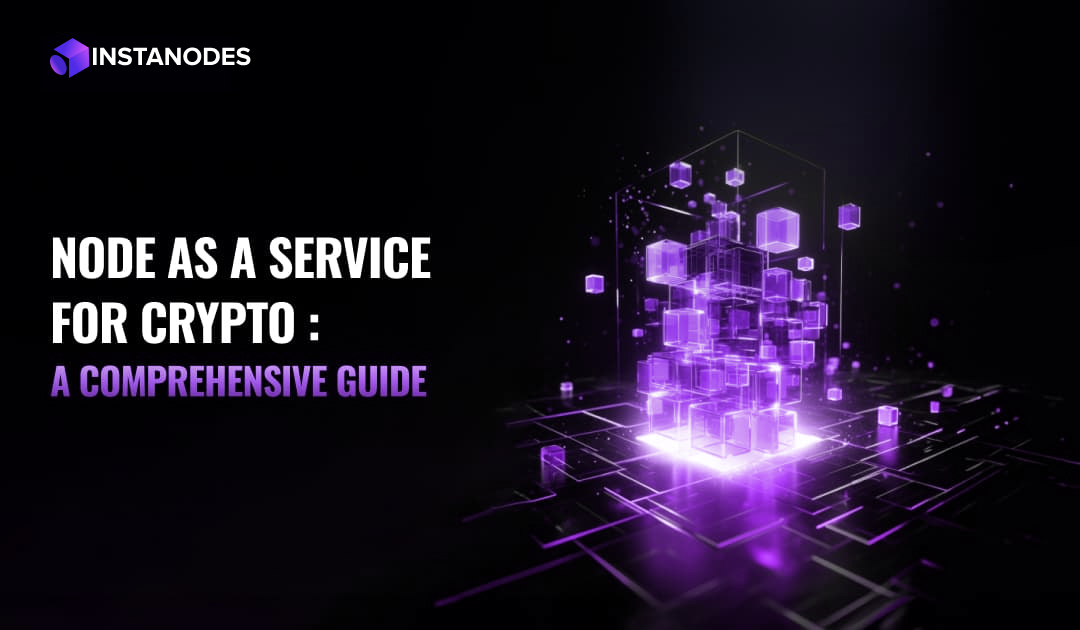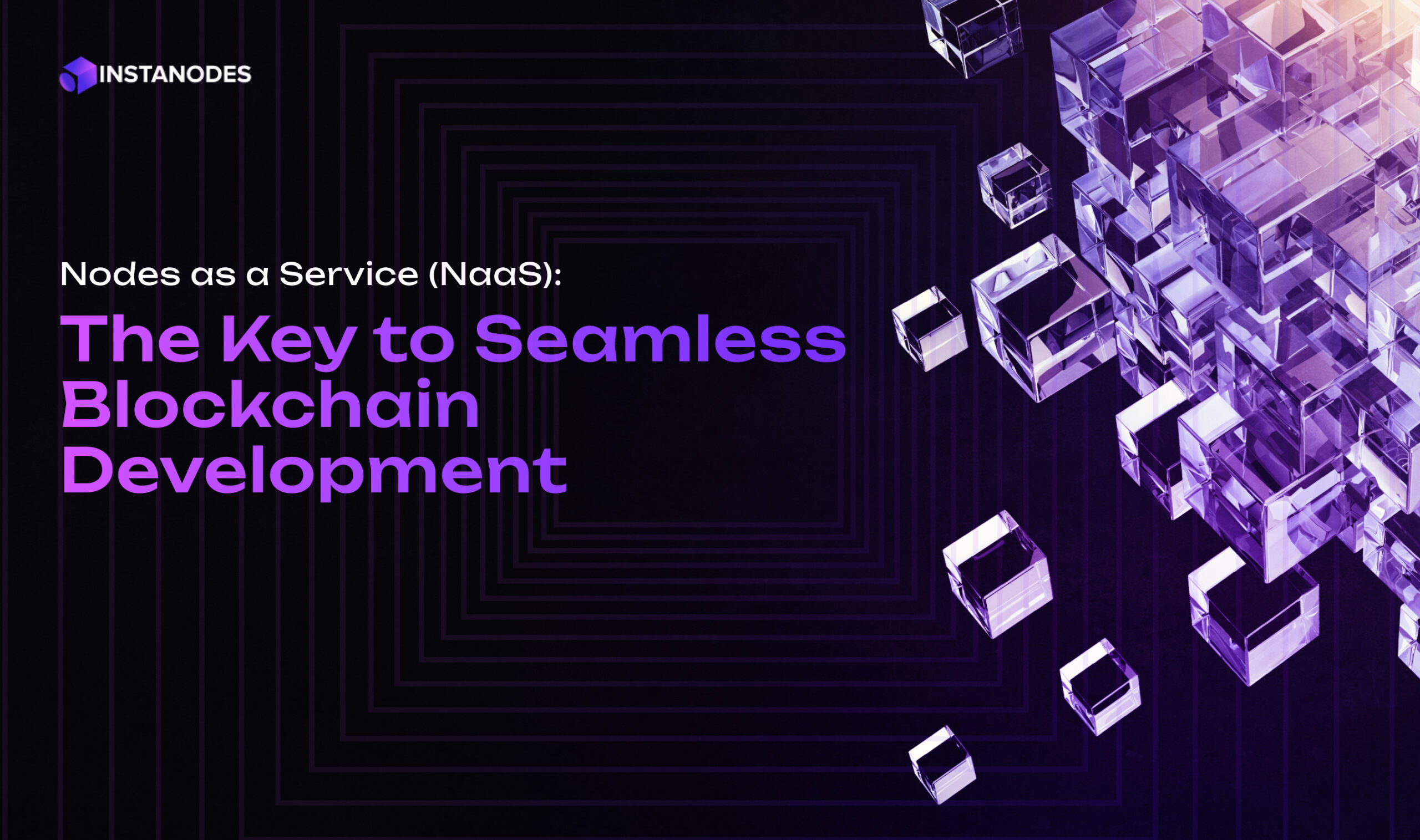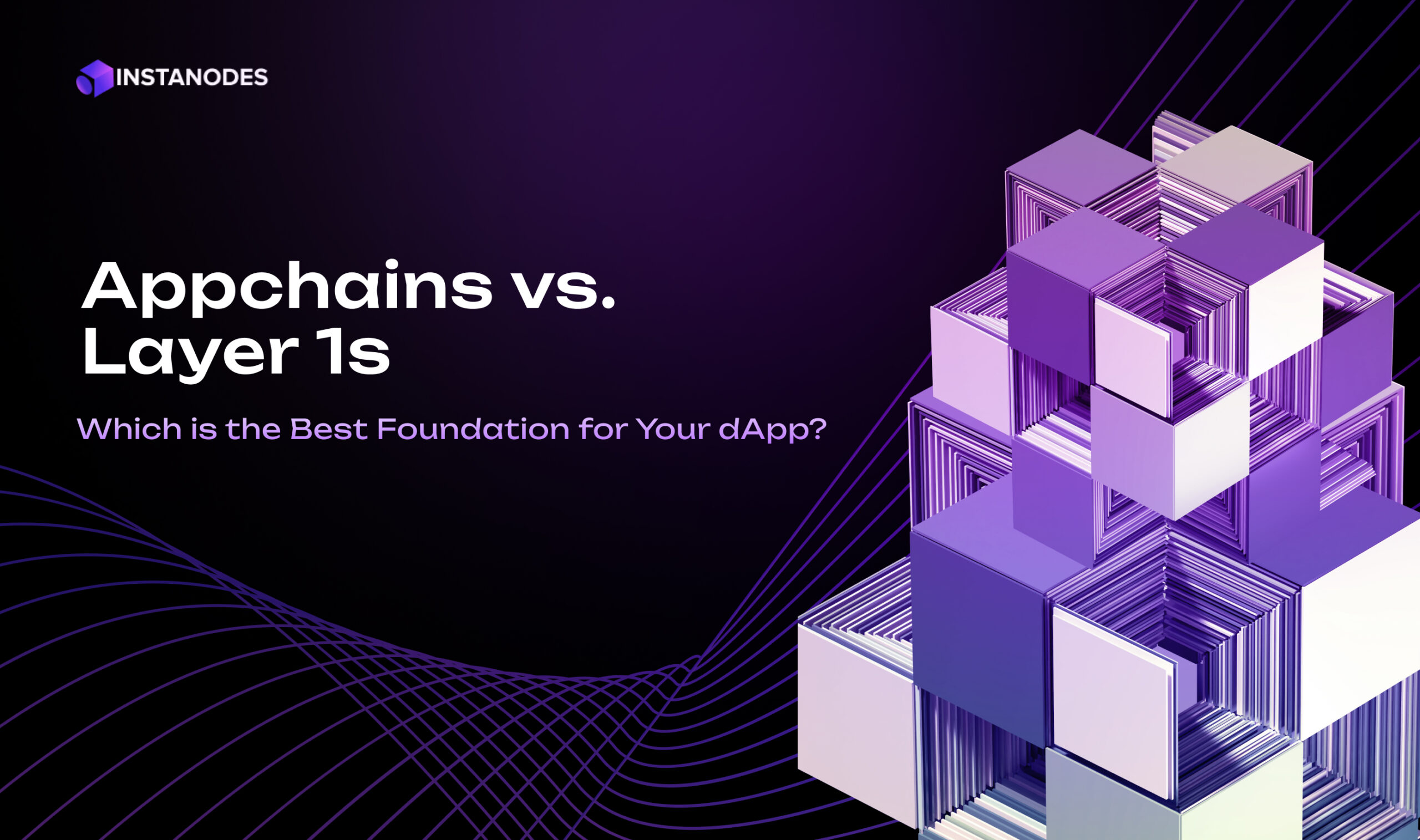The blockchain market has witnessed immense growth in the last couple of years with more and more organizations and individuals viewing it as an ideal tool for secure, transparent, and decentralized transactions. Since the use of blockchain networks picked up speed, concerns about its scalability and expense of transactions increased. That’s where blockchain rollups can rescue the situation and prove to be a silver lining for this conundrum.
Rollups in blockchain enhance transaction throughput and reduce costs as they perform transaction execution off-chain and post only summary data on the main blockchain. Thus, businesses prefer building dApps using crypto rollups to enable faster and cheaper blockchain transactions.
Choosing the right Rollup as a Service is the easiest way of handling the hassles of building scalable infrastructure for decentralized applications. However, before doing that, one must be aware of the difference between crypto ZK rollups and Optimistic rollup, and how both these handle the aspects of transaction speed, cost, and scalability.
The Scalability Problem and the Promise of Blockchain Rollups
Although blockchain technology has completely changed the way we carry out financial transactions and maintain records without losing our confidentiality, we are bothered by its fundamental limitation known as the “blockchain trilemma.” This is a notion developed by Ethereum co-founder Vitalik Buterin that blockchain networks can only optimize two of three attractive properties: decentralization, security, and scalability. Most conventional blockchains such as Bitcoin and Ethereum sacrificed the third in favor of the first two.
The effects of poor scalability manifest in high fees and delayed processing. During their peak, like in the 2017 CryptoKitties incident or the 2020-2021 DeFi bubble, Ethereum’s gas fees mounted to insane amounts that easily charged more than $100 for a simple transaction. Bitcoin is also bound by similar limits, handling some 7 TPS, compared to Ethereum with 15-30 TPS. Central payment processors such as Visa, being centralized, support up to 65,000 TPS. This is where rollup crypto solutions are needed.
Rollup in crypto is a layer-2 scaling solution that performs transactions off the main chain while recording transaction information back on the main chain. By transferring computation off-chain but keeping security ensured through the main blockchain, rollups are able to hugely improve throughput and decrease costs.
The allure of blockchain rollups is strong as they have the potential to scale Ethereum and other networks to thousands of transactions per second and lower fees by orders of magnitude. Rollups can bring throughput up 10-100x over layer-1 processing alone, as per Ethereum’s documentation. This revolutionary potential has established rollups as a mainstay of Ethereum’s scaling plan and has piqued interest throughout the blockchain ecosystem.
Rollups Explained: Bundling Transactions for Off-Chain Execution
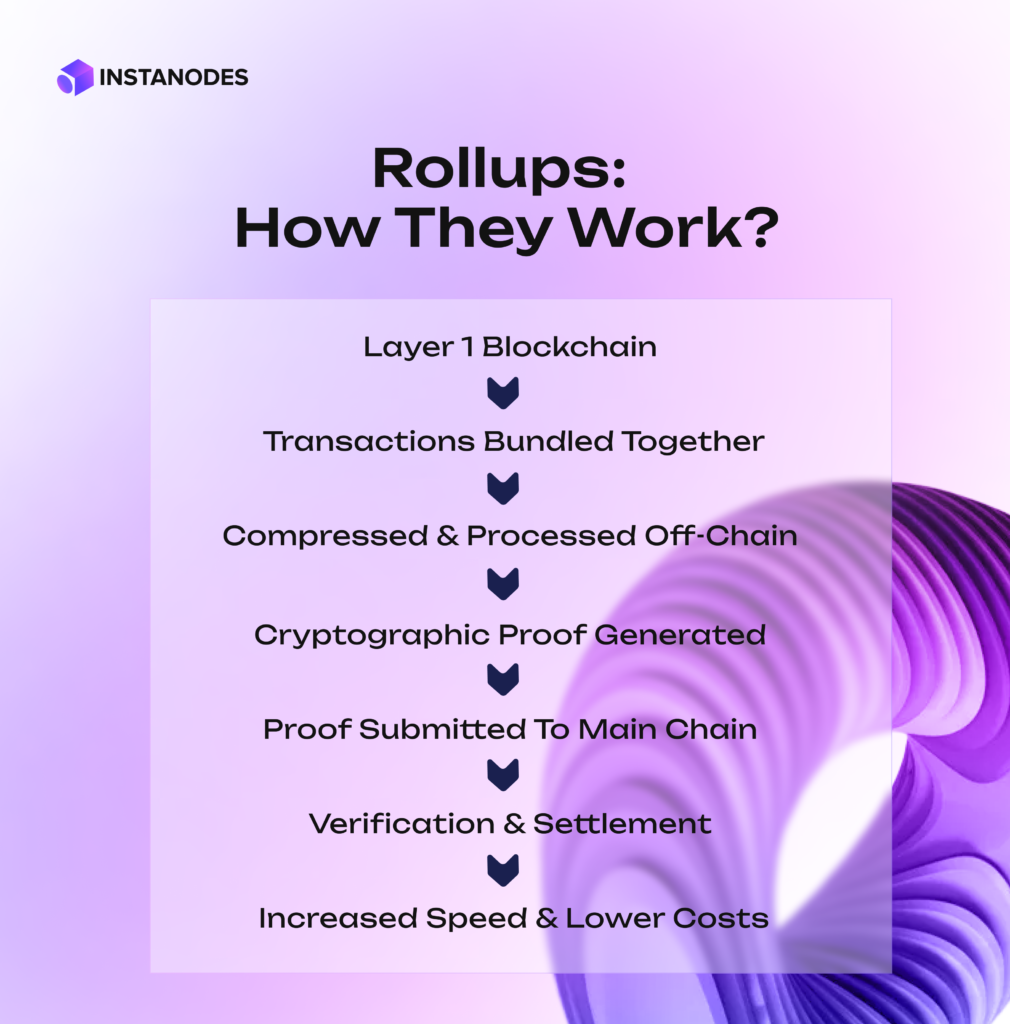
In essence, rollup in crypto is a sophisticated scaling architectural technique. Instead of validating every single transaction on the root blockchain (layer-1), rollups batch or “roll up” several hundred or several thousand transactions together. These batches are then processed off-chain on a separate layer (layer-2), with only the essential proof or data being submitted back to the main chain.
The mechanism works through several key components:
- Transaction Collection
Users submit transactions to the rollup’s smart contract or operator.
- Off-Chain Processing
These transactions are executed in a separate environment outside the main blockchain.
- Batching
Multiple transactions are bundled together into a single data structure.
- Proof Generation
A cryptographic proof or data set that verifies the validity of all transactions in the batch is created.
- Main Chain Submission
This proof or compressed data is submitted to the main blockchain as a single transaction.
- Verification
The main chain verifies the proof or accepts the data, ensuring that all bundled transactions are valid.
This workflow makes it possible to distribute the computational load effectively, because the complex processing is done off-chain while and the main chain just have to handle the verification. As a result, transaction throughput is increased manifold times and a significant reduction in fees also happens. The cost of a single main chain transaction is distributed across hundreds or thousands of rollup transactions.
From the user’s point of view, the transactions done using a rollup crypto solution are similar to that using the main blockchain directly. Users sign transactions with their private keys and submit them to the rollup network. The difference is in the backend processing and the substantially lower fees and faster confirmations that users experience.
A critical aspect of rollups is their inherent security model. Unlike some scaling solutions that operate independently, rollups derive their security from the main blockchain. By submitting transaction information or proofs on-chain, blockchain rollups guarantee that even when the rollup operators are malicious, users’ funds are safe, and the proper state can be restored from the on-chain information.
Ready to Scale with Custom Rollup Infrastructure?
Build, deploy, and manage secure and scalable rollups effortlessly with our Rollup as a Service platform.
Optimistic Rollups vs. ZK Rollups: A Comparison of Validation Strategies
The rollup ecosystem has given rise to two predominant strategies, each characterized by specific features and trade-offs: Optimistic rollups and Zero-Knowledge rollups (crypto ZK rollups). Grasping the differences between these technologies is vital for both developers and users as they navigate the complexities of blockchain scaling.
| Becoming a Validator Node- Key Challenges and Solutions | ||
| Feature | Optimistic Rollup | ZK-Rollups |
| Validation Method | Assumes transactions are valid unless challenged | Uses zero-knowledge proofs for immediate validation |
| Challenge Mechanism | Fraud proofs allow users to dispute invalid transactions | No challenge period; validity proofs ensure correctness |
| Finality Time | Longer (due to challenge period, usually ~7 days) | Instant finality after proof submission |
| Gas Fees | Lower than main chain but higher than ZK-Rollups | Generally lower due to efficient proof mechanisms |
| Smart Contract Compatibility | Supports all Ethereum smart contracts | Limited compatibility, requires modifications |
| Security Model | Relies on economic incentives and fraud detection | Cryptographic security with mathematical proofs |
| Popular Projects | Optimism, Arbitrum | StarkNet, zkSync, Polygon zkEVM |
Optimistic Rollups
As the name reflects, Optimistic rollups operate under the assumption of optimism: transactions are regarded as valid by default unless there is proof to the contrary. This approach includes several fundamental steps.
- Transactions are processed off-chain by sequencers (specialized nodes).
- The results are posted to the main chain without immediate verification.
- A challenge period (typically 7 days) follows, during which anyone can submit a “fraud proof” if they detect an invalid transaction.
- If a “fraud proof” is successfully verified, the invalid batch is rolled back and replaced with the correct one.
Key examples of optimistic rollup implementations include Optimism and Arbitrum. These platforms have experienced remarkable growth, with Optimism rollups executing millions of transactions and hosting a diverse range of decentralized applications.
The advantages of Optimistic rollups include:
- Relatively simple implementation
- EVM compatibility, making it easy to port existing Ethereum applications
- Lower computational requirements for participants
However, Optimistic rollups also have limitations:
- Long withdrawal periods (typically 7 days) due to the challenge window
- Reliance on at least one honest participant to identify fraud
- Additional complexity in handling dispute resolution
ZK-Rollups
Zero-Knowledge rollups take a fundamentally different approach to validation. Instead of assuming transactions are valid and waiting for challenges, crypto ZK rollups use advanced cryptography to mathematically prove the validity of each batch:
- Transactions are processed off-chain.
- A cryptographic argument referred to as a ZK-SNARK (Zero-Knowledge Succinct Non-Interactive Argument of Knowledge) or ZK-STARK is created.
- It checks that every transaction in the batch is legitimate without showing the underlying transaction data.
- The proof is posted to the main chain and verified through a relatively simple computation.
Major ZK-rollup initiatives are zkSync, StarkNet, and Polygon’s zkEVM. Crypto ZK rollups have worked exceptionally well for particular applications such as token swaps and transfers.
The advantages of ZK-rollups include:
- Near-immediate finality once the proof is verified on-chain
- Stronger privacy guarantees due to the zero-knowledge property
- Potentially greater data compression, leading to lower costs
However, ZK-rollups also face challenges:
- Higher computational requirements for generating proofs
- More complex implementation, particularly for general-purpose computation
- Historical limitations in EVM compatibility (though recent advances are addressing this)
The choice between optimistic and ZK approaches involves trade-offs between implementation complexity, withdrawal times, computational requirements, and compatibility with existing infrastructure. Optimistic rollups currently lead in EVM compatibility and developer adoption, while crypto ZK rollup offer advantages in finality time and potential for privacy.
As rollup technology matures, we’re seeing a convergence where both approaches are adopting each other’s strengths. Optimistic rollups are working to reduce challenge periods, while ZK-rollups are improving their EVM compatibility and reducing proof generation costs.
How Rollups Enhance Throughput and Reduce Gas Fees
Rollups in blockchain impacts performance dramatically and benefit users by addressing two of the most significant pain points: transaction throughput and gas fees. This improvement stems from the fundamental architectural change that rollups introduce to transaction processing.
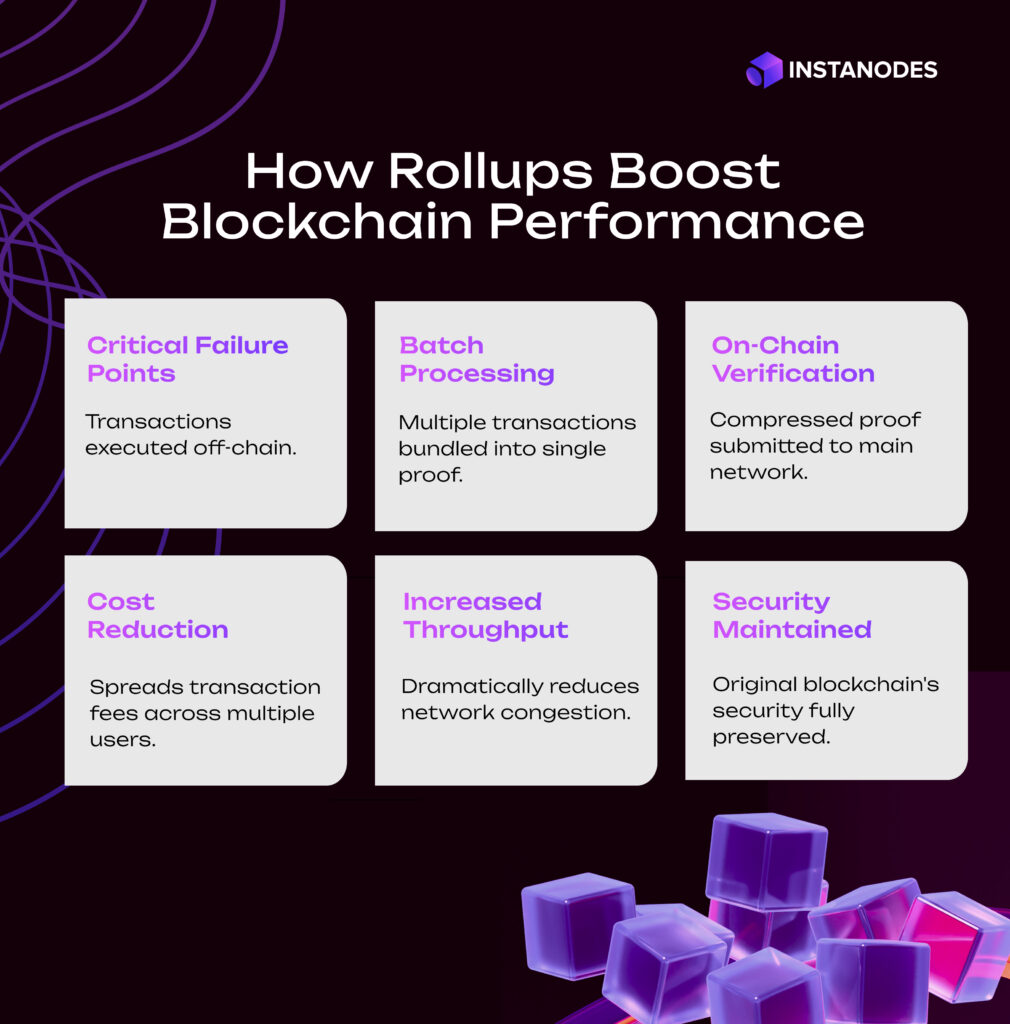
Enhanced Transaction Throughput
Conventional blockchain networks handle all the transactions on the base chain with every node on the network performing the same action. This redundancy ensures security but severely limits throughput. Rollups dramatically increase capacity through several mechanisms:
- Parallel Processing
While the main chain continues its normal operation, rollups process transactions in parallel, effectively adding a new processing lane to the blockchain highway.
- Batching Efficiency
By bundling hundreds or thousands of transactions into a single batch, rollups achieve economies of scale in processing.
- Specialized Execution
Rollup operators can optimize their execution environments specifically for transaction processing, without the overhead of maintaining a full consensus mechanism.
The numbers speak for themselves. While Ethereum’s layer-1 manages approximately 15-30 TPS, rollup solutions can theoretically process thousands of transactions per second. Optimism rollups and other implementations have demonstrated throughput improvements of 10-100x compared to base layer processing. As rollup technology matures and implements further optimizations, these numbers are expected to increase even further.
Substantial Fee Reduction
The high gas fees on networks like Ethereum have been a significant barrier to adoption. Rollups address this issue directly:
- Cost Amortization
The cost of a single layer-1 transaction is spread across all the transactions in a rollup batch. If a batch contains 1,000 transactions, each user might pay just 1/1000th of the base layer fee.
- Data Compression
Rollups use numerous compression mechanisms to lower the quantity of data committed to the main chain, which means an additional reduction in costs.
- Competition Among Rollups
With numerous competing crypto rollups solutions, they gain incentives to optimize for lower fees and improved performance.
In practice, rollups have achieved remarkable fee reductions. Transactions on optimistic rollup chains such as Arbitrum and Optimism usually cost 3-10 times less than similar transactions on Ethereum’s base layer. Crypto ZK rollups have proven even more efficient in some instances, with fees cut by factors of 10-100x for specific operations.
Real-World Impact
The throughput enhancement and fee reduction provided by rollups have real-world implications for blockchain applications:
- Viable Microtransactions
With significantly lower fees, use cases involving small payments become economically viable.
- Improved User Experience
Faster confirmations and reduced costs provide a more seamless experience for end users.
- New Application Categories
The enhanced performance supports new classes of applications that would be infeasible on busy base layers, including gaming, social media, and high-frequency trading.
- Increased Accessibility
Reduced costs bring blockchain applications within reach of users in regions with lower purchasing power.
As businesses are increasingly becoming adaptive to blockchain technology, the role of Rollup as a Service has become significant, as it allows developers to leverage scaling benefits without facing the intricacies of building and maintaining a rollup infrastructure on their own.
Data Availability: Ensuring Security and Trustworthiness in Rollup Networks
Availability of data is a critical aspect of crypto rollups security. It’s necessary to ensure that the data required for transaction validation and reconstruction of the state is accessible to all network participants. It’s a most basic consideration for maintaining the guarantee of security that is expected by the users while using the blockchain systems.
The Data Availability Challenge
In rollup architectures, a key question emerges: how much data should be posted on-chain versus kept off-chain? This question leads to different approaches:
- Full Data Availability
All transaction data is posted on the main chain, ensuring that anyone can verify and reconstruct the rollup state independently.
- Partial Data Availability
Only compressed transaction data or validity proofs are posted on-chain, with full data stored elsewhere.
The choice between these approaches involves trade-offs between cost, security, and decentralization. Posting all data on-chain maximizes security but increases costs. Keeping data off-chain reduces costs but potentially introduces new trust assumptions.
ZK-Rollups and Data Availability
ZK rollups have a unique advantage in the data availability landscape. Because they post cryptographic proofs that mathematically verify transaction validity, they can potentially store less data on-chain while maintaining security. This approach:
- Allows for greater compression of on-chain data
- Maintains verifiability through the zero-knowledge proofs
- Can reduce costs while preserving security guarantees
However, even ZK rollups must consider data availability carefully. Without access to the underlying transaction data, certain types of dispute resolution become impossible, and the ability to exit the rollup during emergencies may be compromised.
Optimistic Rollups and Data Availability
Optimistic rollups face a more direct data availability requirement. Because their security model relies on fraud proofs—where observers can challenge invalid state transitions—transaction data must be available for verification. This typically means:
- Posting sufficient data on-chain to enable fraud proofs
- Ensuring challengers can access the information needed to detect fraud
- Maintaining data availability throughout the challenge period
Optimistic rollup projects like Optimism and Arbitrum have developed sophisticated approaches to balance data availability with cost-efficiency, including data compression techniques and optimized encoding methods.
Emerging Solutions
The blockchain ecosystem is developing novel solutions to the data availability challenge:
- Data Availability Committees (DACs)
Trusted groups responsible for storing and attesting to data availability.
- Data Availability Sampling (DAS)
A technique where nodes verify data availability by sampling random chunks of data.
- Dedicated Data Availability Layers
Specialized blockchains or protocols focused specifically on storing and verifying data availability.
- Hybrid Approaches
Combinations of on-chain and off-chain data with various trust models and verification mechanisms.
These approaches aim to provide the security guarantees of full on-chain data availability with the cost efficiencies of off-chain storage.
Boost Your Network’s Speed And Reduce Costs
Integrate blockchain rollups for seamless scalability now!
How Instanodes Provides Scalable Infrastructure to Businesses
With the growing awareness about blockchain rollups among businesses and individuals, the need to find experts for building a reliable infrastructure has become highly important. In this scenario, Instanodes has become a key provider of Rollup as a Service, and offers specialized infrastructure tailored to the unique requirements of blockchain based ventures.
Infrastructure Challenges for Rollup Networks
Rollup networks present distinct infrastructure requirements compared to traditional blockchain nodes:
- Sequencer Operations
Reliable infrastructure for transaction ordering and batch creation
- Proof Generation
Computational resources for creating validity proofs (for crypto ZK rollup)
- Data Validation
Systems for verifying transaction data and processing state transitions
- Cross-Layer Communication
Infrastructure for handling communication between layer-1 and layer-2
These requirements demand specialized knowledge and infrastructure optimization that many businesses lack internally.
Instanodes’ Comprehensive Rollup Infrastructure
Instanodes addresses these challenges by providing end-to-end infrastructure solutions for businesses leveraging rollup technology:
- Dedicated Rollup Nodes
Optimized infrastructure for dedicated rollup deployments, such as Optimism rollups, Arbitrum, and crypto ZK rollups solutions.
- Rollup as a Service (RaaS)
Managed services that deal with the intricacies of rollup deployment, execution, and upkeep so that businesses can concentrate on their core applications.
- High-Performance Computing
Specialized hardware configurations designed for efficient proof generation and transaction processing.
- Reliability and Uptime
Enterprise-grade infrastructure with redundancy and monitoring to ensure continuous operation of critical rollup components.
- Cross-Chain Integration
Infrastructure that facilitates seamless interaction between different blockchain layers and networks.
Business Benefits of Specialized Rollup Infrastructure
By leveraging Instanodes’ infrastructure, businesses can realize several key advantages:
- Reduced Operational Complexity
Offloading technical rollup infrastructure complexity to experts enables development teams to concentrate on creating applications instead of running infrastructure.
- Cost Efficiency
Shared infrastructure and scale economics lower the expense of deploying and running rollup solutions in comparison to creating in-house capabilities.
- Faster Time-to-Market
Pre-configured rollup infrastructure facilitates faster application deployment, shortening time-to-market for blockchain products.
- Scalability on Demand
Cloud infrastructure that scales with usage patterns to support growth without the need for ongoing reconfiguration.
- Technical Support
Specialized expertise access for troubleshooting and optimizing rollup implementations.
Conclusion
Rollups in blockchain are one of the most promising methods for overcoming the long-standing scalability issues that have hindered more extensive blockchain deployment. By decoupling computation from the blockchain, while preserving security via the root blockchain, blockchain rollups present an attractive solution without compromising the basic advantages of blockchain technology.
There are two main crypto rollup flavors—optimistic and ZK—each offer different solutions to the validation problem with their respective strengths. Optimistic rollups are simple and backwards-compatible with current smart contracts but have longer withdrawal times. Crypto ZK rollup have quicker finality and confidentiality advantages but use more complicated cryptography. Both solutions are constantly changing quickly, with research ongoing into addressing their respective weaknesses.
The advantages of rollup in crypto are enormous and profound. In dramatically scaling transaction throughput and diminishing fees, rollups make blockchain technology feasible.
